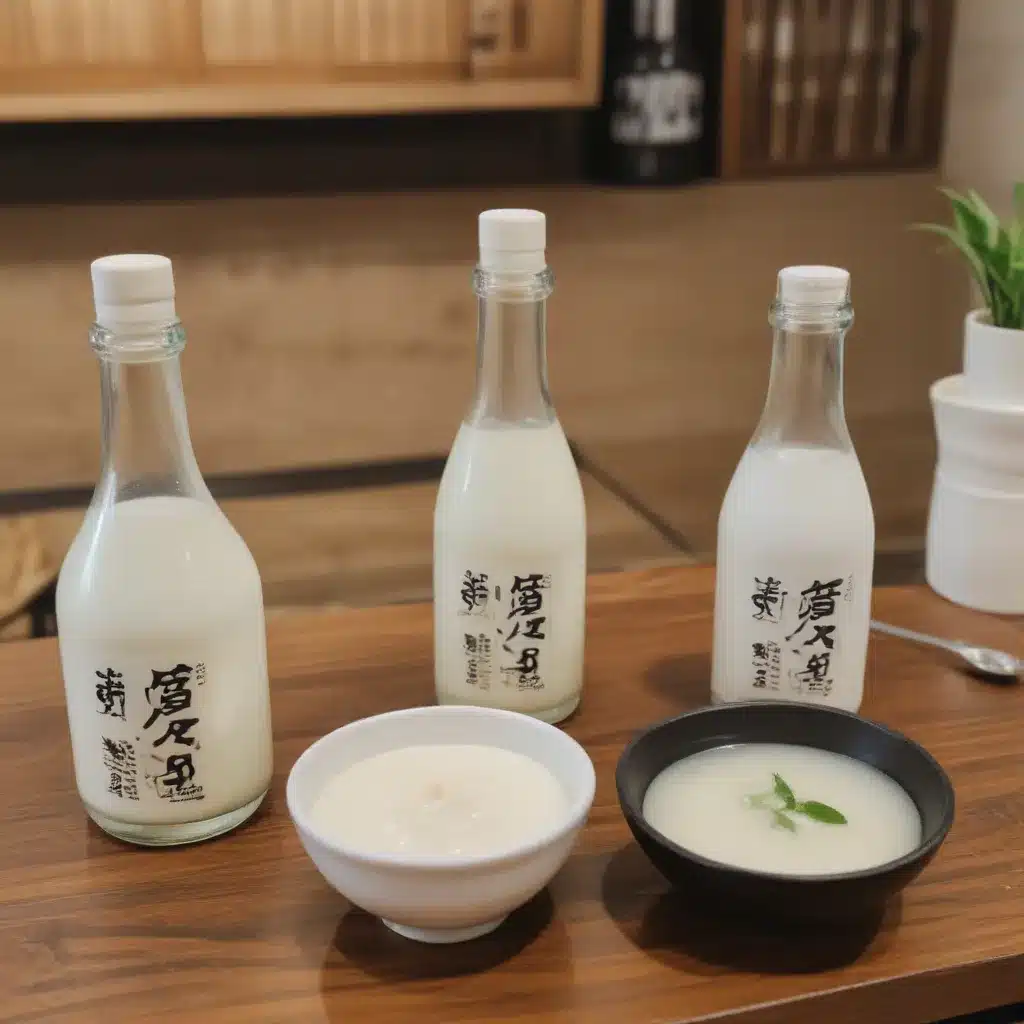
Makgeolli: A Neglected Gem Rediscovered
As I strolled through the bustling streets of Seoul, I couldn’t help but feel a sense of intrigue about the city’s vibrant drinking culture. Sure, I’d heard all about the ubiquitous soju bottles, but there was one traditional Korean beverage that had managed to pique my curiosity: makgeolli.
My first encounter with this enigmatic rice-based drink happened quite by accident. I was wandering through the lively Gwangjang Market, the air thick with the aroma of sizzling mung bean pancakes, when I stumbled upon a stall that promised a unique culinary experience. Without hesitation, I took a seat and ordered a bowl of the freshly fried delicacies, eager to pair them with whatever local libation the vendor recommended.
As I soon discovered, that recommendation would change the course of my Korean drinking journey forever. With the first sip, I was transported to a world of flavors I never knew existed – a softly sweet, funky, and pungent brew that bore a remarkable resemblance to a rich, chocolatey Belgian ale. I was hooked.
Unraveling the Mysteries of Makgeolli
For the remainder of my time in Seoul, I found myself on a quest to uncover the secrets of this enigmatic drink. I visited bars and restaurants that specialized in serving up the finest makgeolli, each variety offering its own unique twist on the traditional recipe. From the thick, creamy varieties to the effervescent, champagne-like iterations, I sampled them all, marveling at the incredible diversity this humble beverage could possess.
As I delved deeper into the world of makgeolli, I learned that this traditional Korean liquor is no mere afterthought. In fact, it is believed to be one of the oldest alcoholic beverages on the Korean Peninsula, with a history spanning centuries. Its production process, which involves a complex fermentation using a starter known as nuruk, results in a drink that is far more akin to beer than the rice wines it is often mistaken for.
The Rise, Fall, and Resurgence of Makgeolli
Interestingly, makgeolli’s journey has not been without its ups and downs. Until the late 1980s, it was the most consumed liquor in South Korea, a staple in the lives of Koreans from all walks of life. However, as the country’s drinking habits evolved and imports of foreign alcohols increased, makgeolli’s popularity began to wane. For a time, it was dismissed as a cheap and low-quality drink, favored only by the elderly and the underprivileged.
But just when it seemed like makgeolli was on the verge of disappearing altogether, a remarkable resurgence began to take shape. Around 2009, Korean consumers started rediscovering their traditional liquors, driven in part by the government’s efforts to promote rice-based products. Suddenly, makgeolli was back in the spotlight, with high-quality varieties commanding prices on par with wine and sake.
Soju: The Ubiquitous Spirit of Korea
While makgeolli may have captured my heart, no exploration of Korean drinking culture would be complete without a deep dive into the nation’s other beloved libation: soju.
As a Korean myself, I have a somewhat complicated relationship with soju. Growing up, I never quite understood the appeal of this clear, distilled spirit, often dismissing it as little more than a “bottle of ethanol” that you might find in a laboratory. But as I ventured out into the vibrant nightlife of Seoul, I couldn’t help but notice the ubiquity of soju, with foreigners and locals alike seemingly gravitating towards it with equal fervor.
The Allure of Soju
So, what is it about soju that has captured the hearts and taste buds of so many around the world? For starters, there’s the sheer ubiquity of the drink – I can’t walk more than a few blocks in Seoul without stumbling upon a convenience store or a bar that offers soju. It’s a staple in the lives of Koreans, a go-to accompaniment for everything from casual gatherings to formal business meetings.
But beyond its pervasiveness, soju also has a certain allure that transcends cultural boundaries. With its clean, crisp flavor and relatively low alcohol content (typically around 20%), it’s a remarkably versatile spirit that can be enjoyed on its own or mixed into a variety of cocktails. And let’s not forget the ritual of drinking soju, which often involves sharing a bottle with friends and engaging in lively conversation – a tradition that seems to captivate foreigners and Koreans alike.
Embracing the Diversity of Soju
Of course, as with any beloved beverage, soju has evolved over the years, with enterprising distillers experimenting with new flavors and production methods. From the classic soju-and-beer mixture to more innovative concoctions infused with everything from fruits to herbs, there’s a soju for every palate and occasion.
As I continue to explore the vibrant drinking culture of Seoul, I find myself increasingly drawn to the diversity and rich history of these traditional Korean beverages. Whether it’s the funky, effervescent makgeolli or the crisp, versatile soju, there’s a depth of flavor and cultural significance that goes far beyond the simple act of imbibing.
So, the next time you find yourself in Seoul, I urge you to step outside your comfort zone and embrace the city’s age-old drinking traditions. Who knows – you might just discover a new favorite beverage that will forever change the way you think about Korean culture. And if you’re ever in the market for a comfortable place to rest your head after a night of soju-fueled revelry, be sure to check out Hotel Stay Inn Seoul – the perfect home base for your Seoul adventures.

